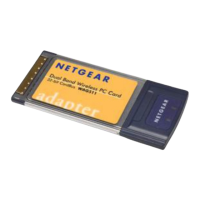Wireless Channel Selection
802.11b and 802.11g
IEEE 802.11b and 802.11g wireless nodes communicate with each other using radio frequency
signals in the ISM (Industrial, Scientific, and Medical) band between 2.4 GHz and 2.5 GHz.
Neighboring channels are 5 MHz apart. However, due to spread spectrum effect of the signals,
a node sending signals using a particular channel will utilize frequency spectrum 12.5 MHz
above and below the center channel frequency. As a result, two separate wireless networks using
neighboring channels (for example, channel 1 and channel 2) in the same general vicinity will
interfere with each other. Applying two channels that allow the maximum channel separation
will decrease the amount of channel cross talk, and provide a noticeable performance increase
over networks with minimal channel separation.
Service Set Identification (SSID)
The Service Set Identification (SSID) is a thirty-two alphanumeric character (maximum)
string identifying the wireless local area network. Some vendors refer to the SSID as network
name. For stations to communicate with each other, all stations must be configured with the
same SSID.
A wireless LAN consisting of nodes operating in Ad-hoc configuration without an Access
Point is called a Basic Service Set (BSS). All nodes in a BSS must use the same Basic Service
Set ID (BSSID).
In an infrastructure configuration with Access Points, multiple BSS can be configured to form
an Extended Service Set (ESS). In this configuration, the Access Points are configured with the
same Extended Service Set ID (ESSID). Wireless clients configured with the same ESSID can
freely roam from one Access Point domain to another and still maintain seamless connection to
the network.
Authentication and WEP Encryption
The absence of a physical connection between nodes makes the wireless links vulnerable to
information theft. To provide a certain level of security, IEEE 802.11 standard has defined two
types of authentication methods, Open System and Shared Key. Open System authentication is
a null algorithm. Shared Key authentication is an algorithm where both the transmitting node
and the receiving node share an authentication key to perform a checksum on the original
message. By default, IEEE 802.11 wireless devices operate in an open system network.
Wired Equivalent Privacy (WEP) data encryption is utilized when the wireless nodes or
access points are configured to operate in Shared Key authentication mode. There are three
shared key methods implemented in NETGEAR’s 802.11a/b solutions: the standard based
64-bit WEP data encryption and 128-bit WEP data encryption plus the extended 152-bit
WEP data encryption.
The 64-bit WEP data encryption method allows for a five-character (40 bits) input.
Additionally, 24 factory-set bits are added to the 40-bit input to generate a 64-bit encryption
key. (The 24 factory-set bits are not user configurable.) This encryption key will be used to
encrypt/decrypt all data transmitted via the wireless interface. Some vendors may refer to the
64-bit WEP data encryption as 40-bit WEP data encryption since the user configurable key
used in the encryption process is only 40 bits wide.
The 128-bit WEP data encryption method consists of 104 configurable bits and the 152-bit
WEP data encryption method consists of 128 configurable bits. Similar to the 64-bit WEP
data encryption method, the remaining 24 bits are factory set and not user configurable.
Encryption
Key Size
# of Hexadecimal
Digits
Example of Hexadecimal
Key Content
64-bits (24+40) 10 4C72F08AE1
128-bit (24+104) 26 4C72F08AE19D57A3FF6B260037
152-bit (24+128) 32 4C72F08AE19D57A3FF6B26003715DAC2
Channel Center Frequency Frequency Spread
1 2412 MHz 2399.5 MHz – 2424.5 MHz
2 2417 MHz 2404.5 MHz –2429.5 MHz
3 2422 MHz 2409.5 MHz –2434.5 MHz
4 2427 MHz 2414.5 MHz –2439.5 MHz
5 2432 MHz 2419.5 MHz – 2444.5 MHz
6 2437 MHz 2424.5 MHz –2449.5 MHz
7 2442 MHz 2429.5 MHz –2454.5 MHz
8 2447 MHz 2434.5 MHz – 2459.5 MHz
9 2452 MHz 2439.5 MHz –2464.5 MHz
10 2457 MHz 2444.5 MHz –2469.5 MHz
11 2462 MHz 2449.5 MHz – 2474.5 MHz
12 2467 MHz 2454.5 MHz – 2479.5 MHz
13 2472 MHz 2459.5 MHz – 2484.5 MHz
21
20

